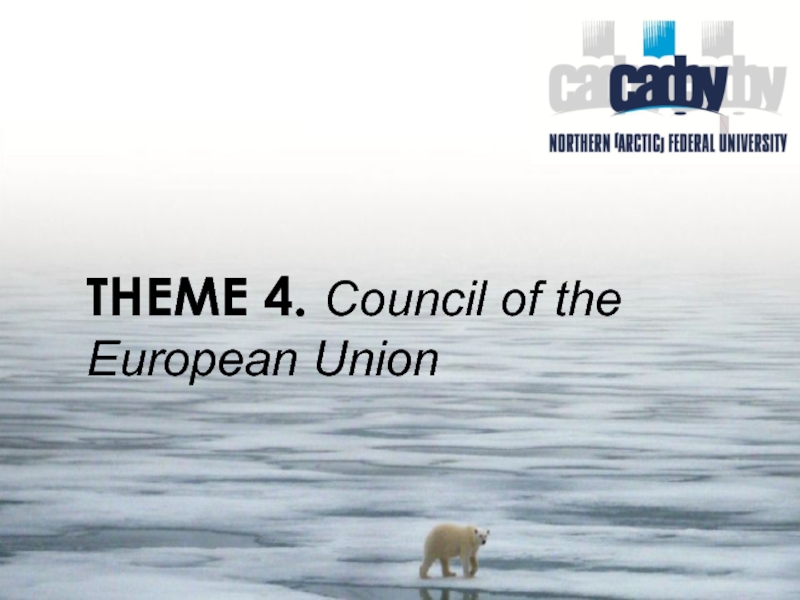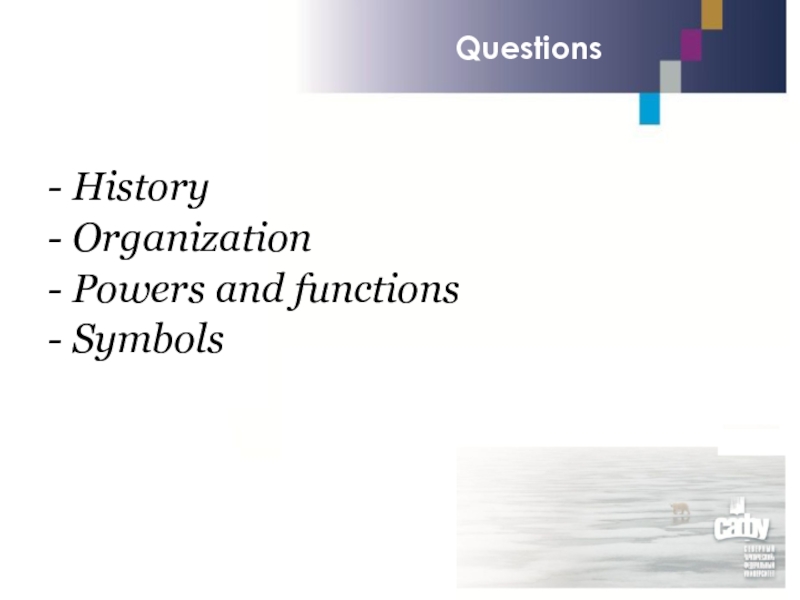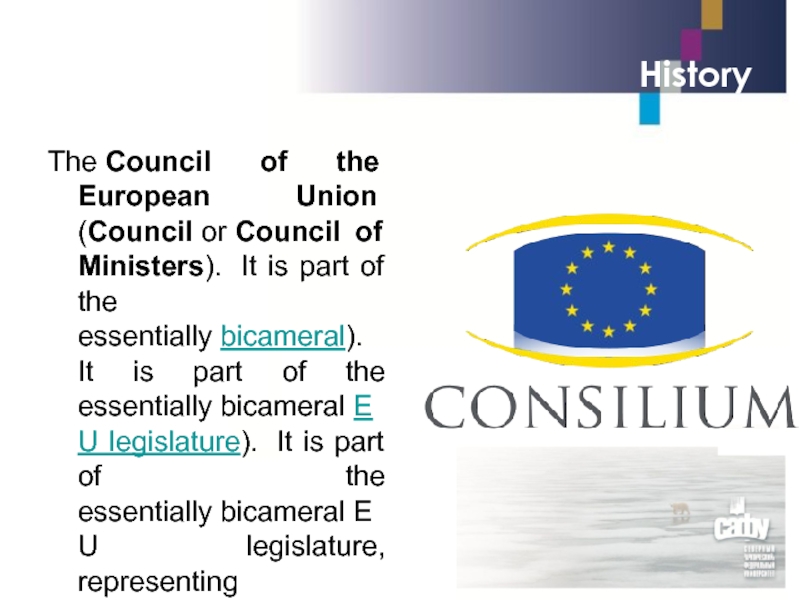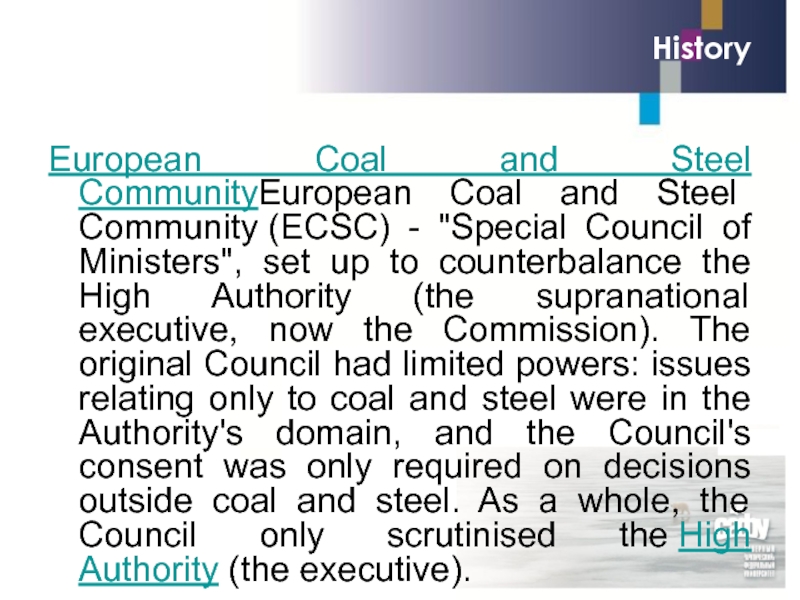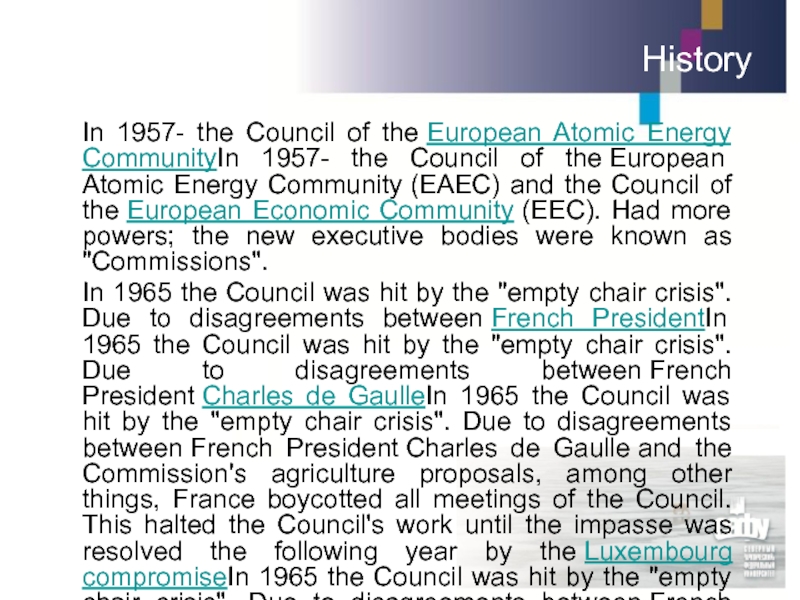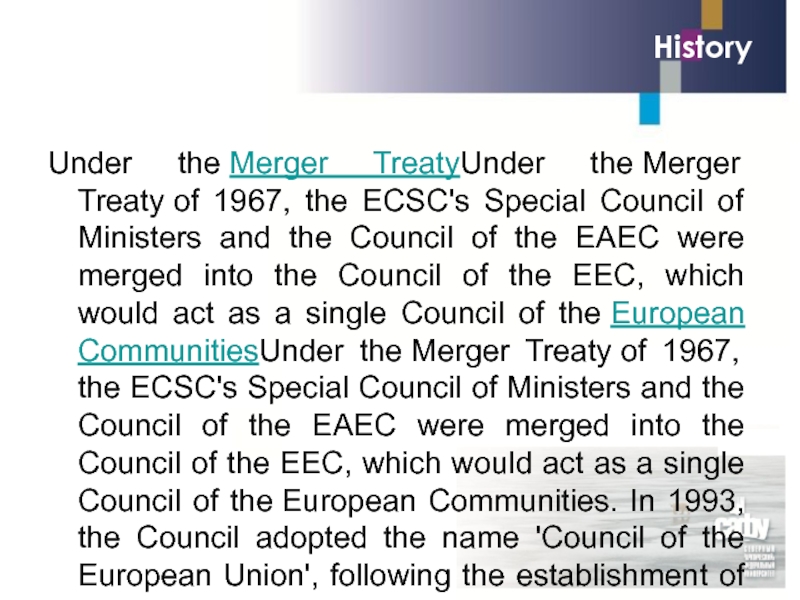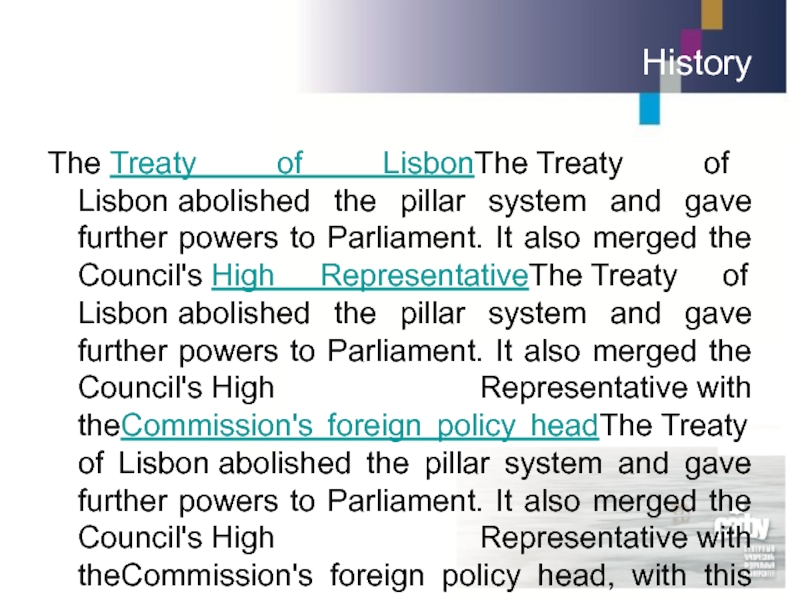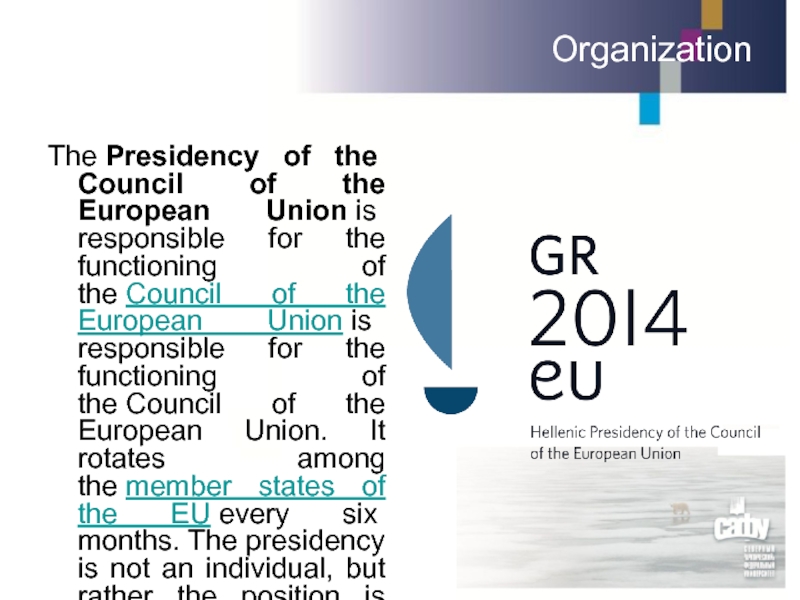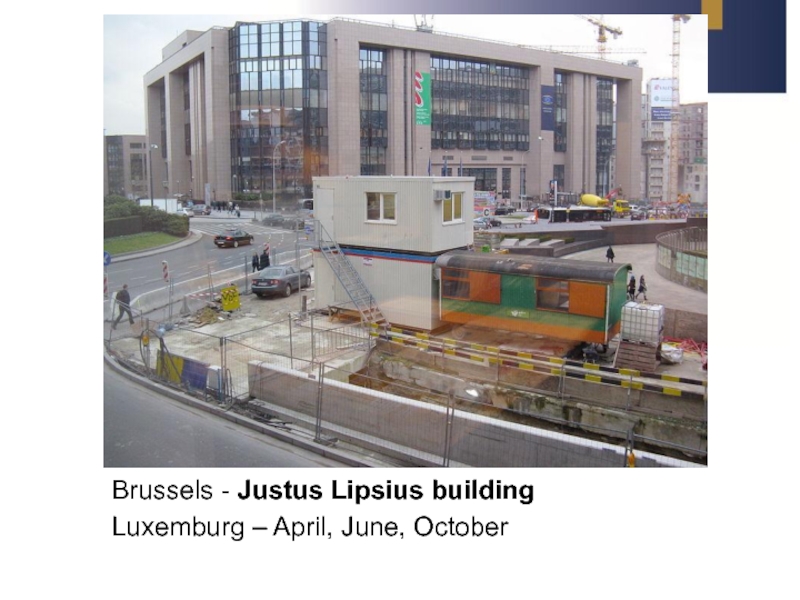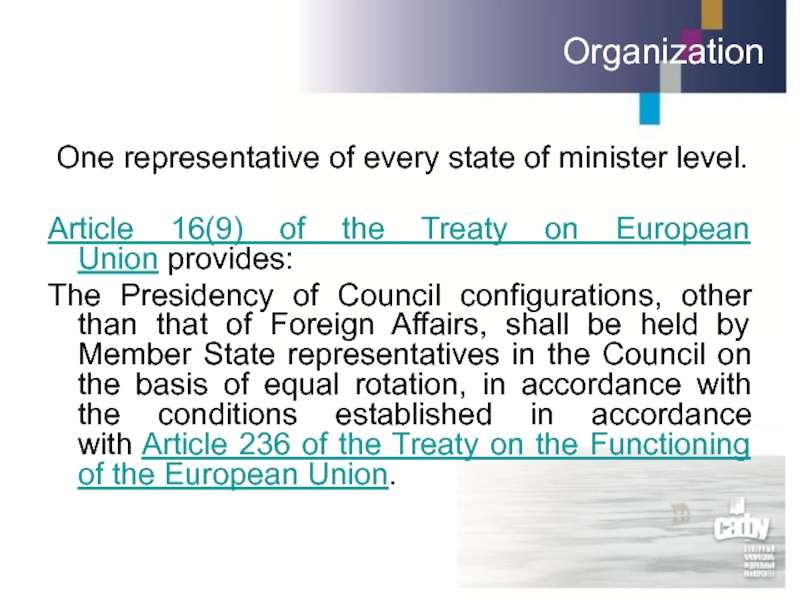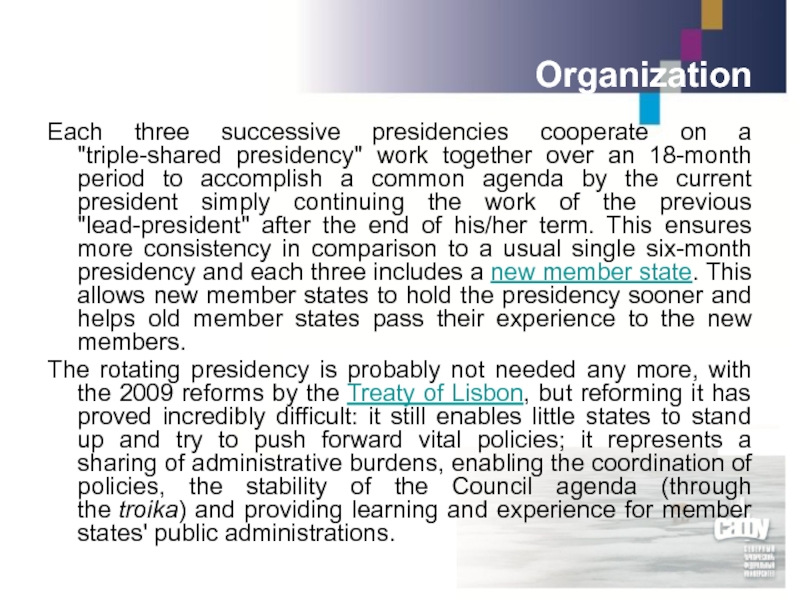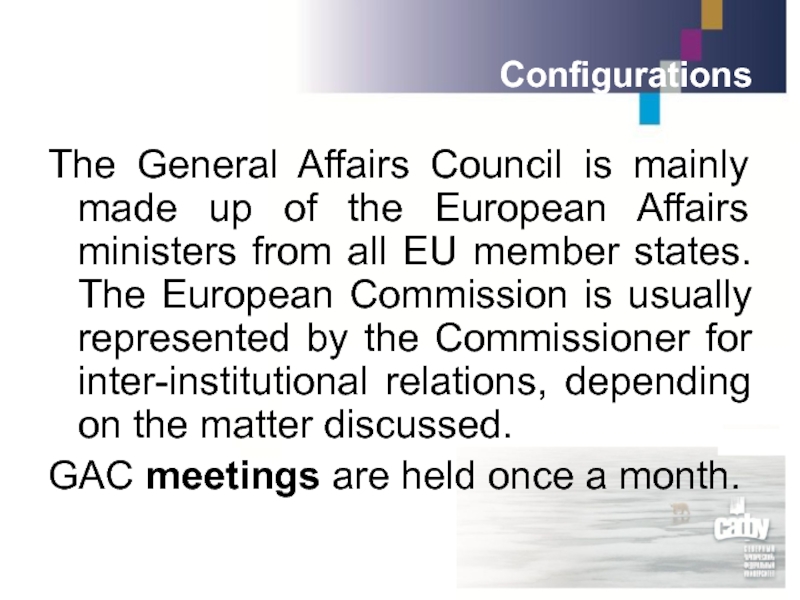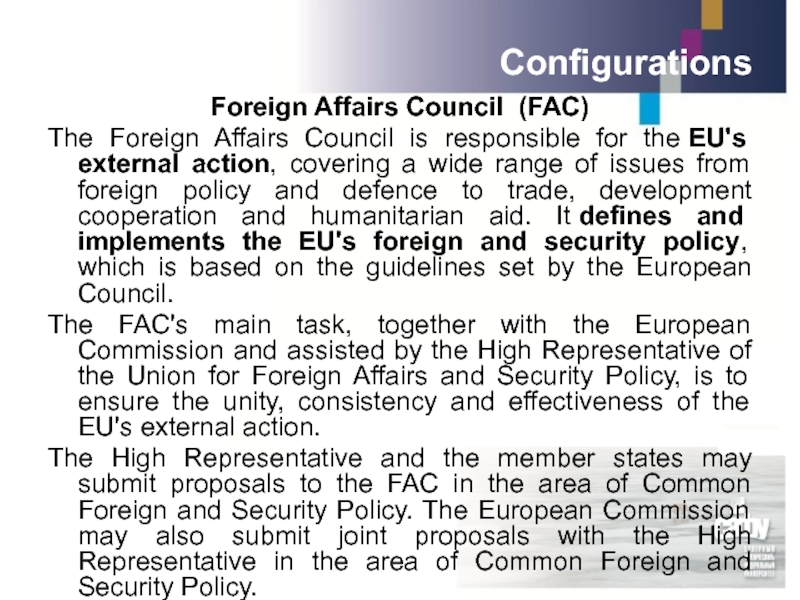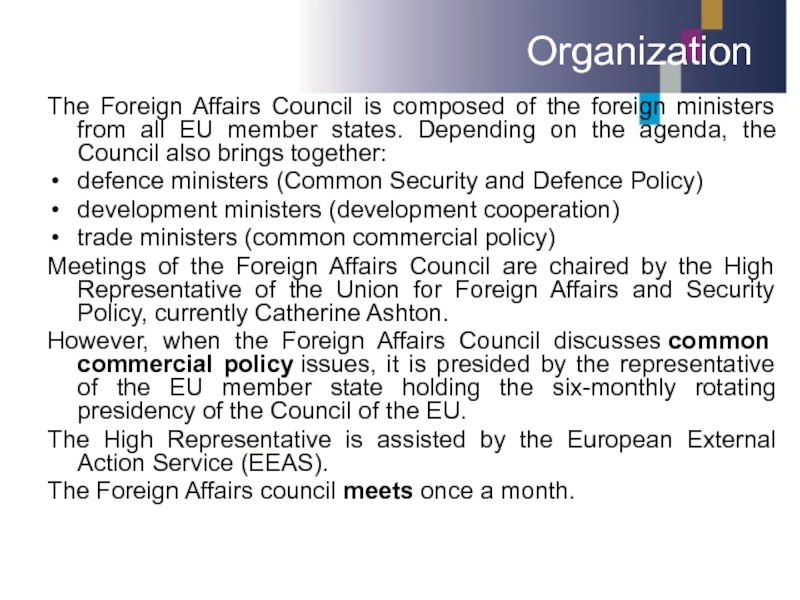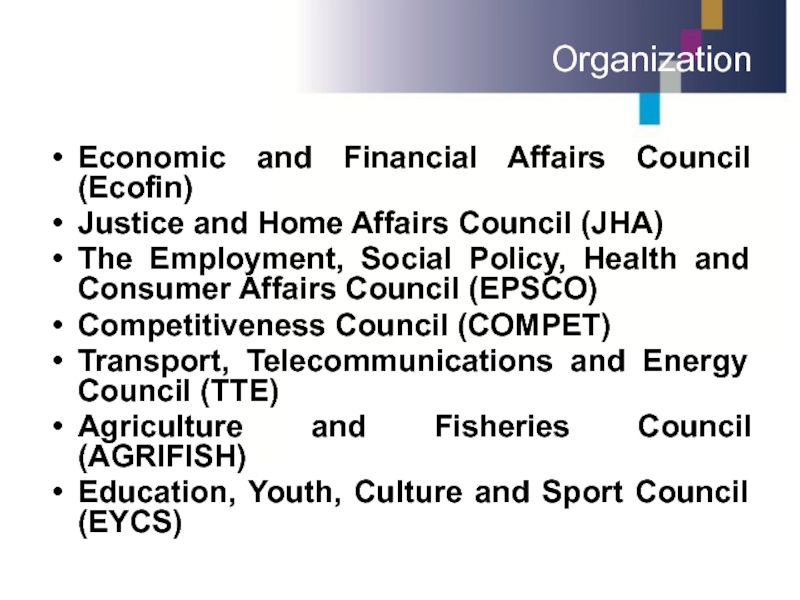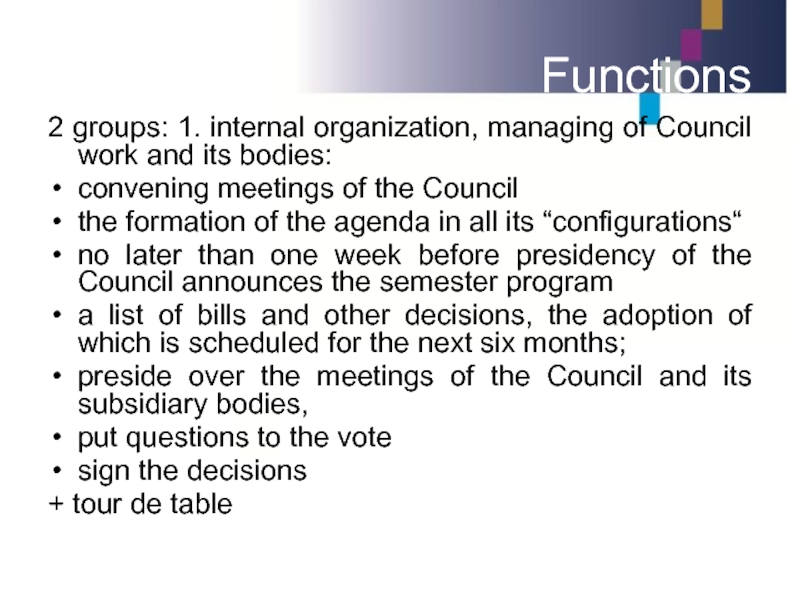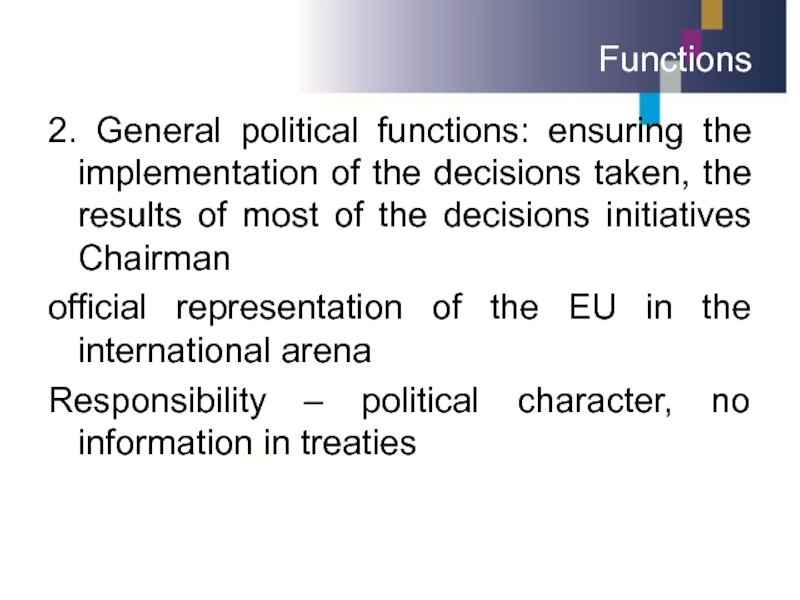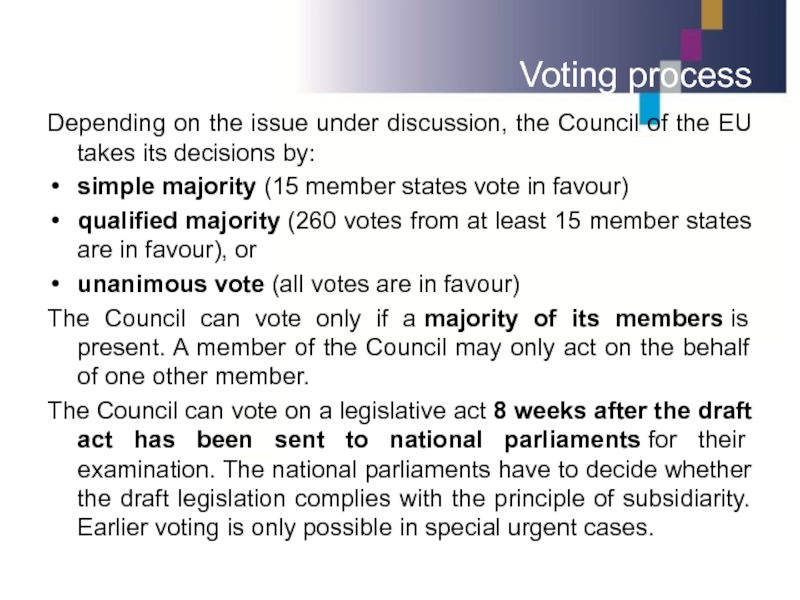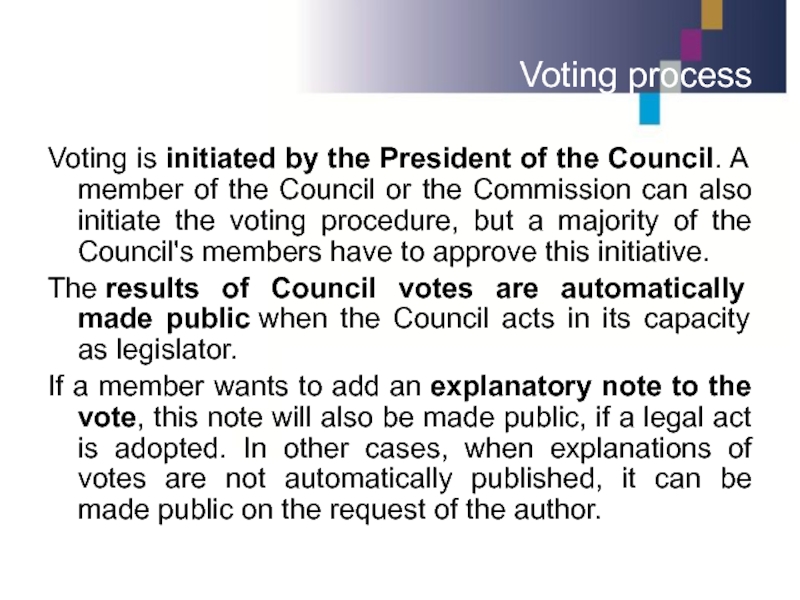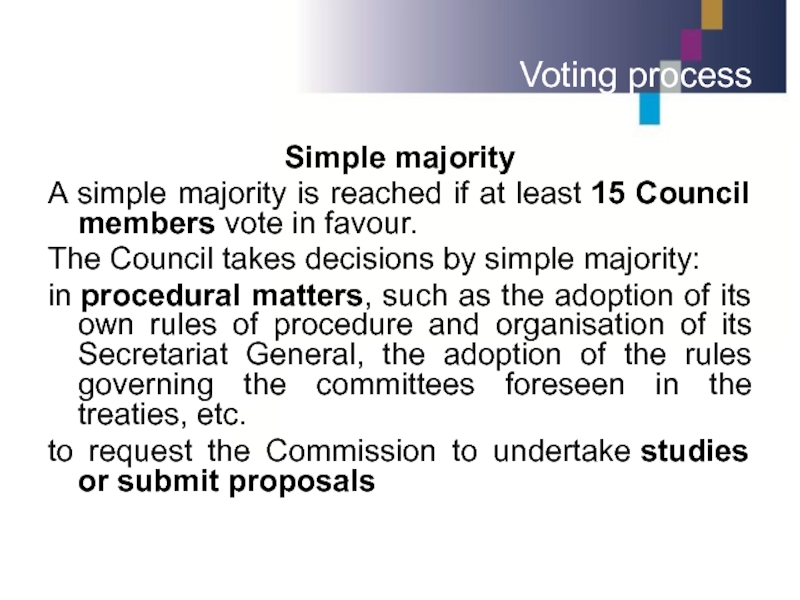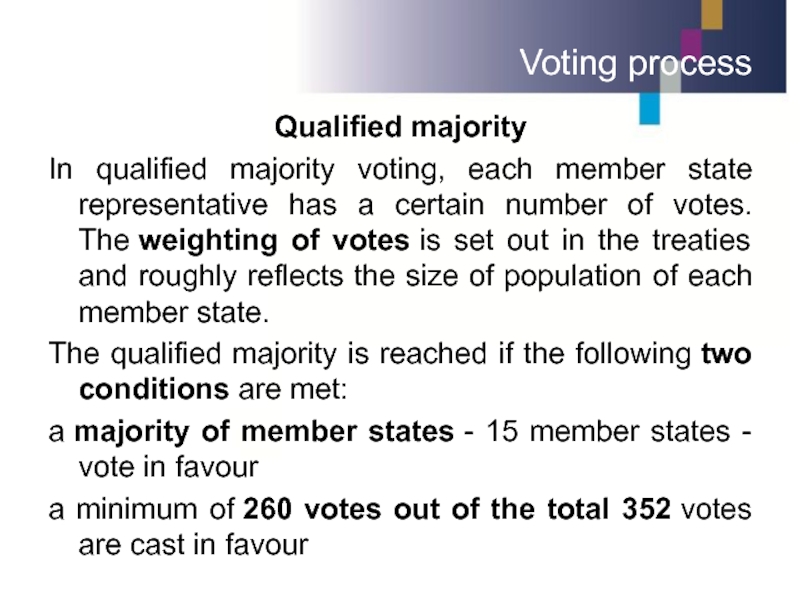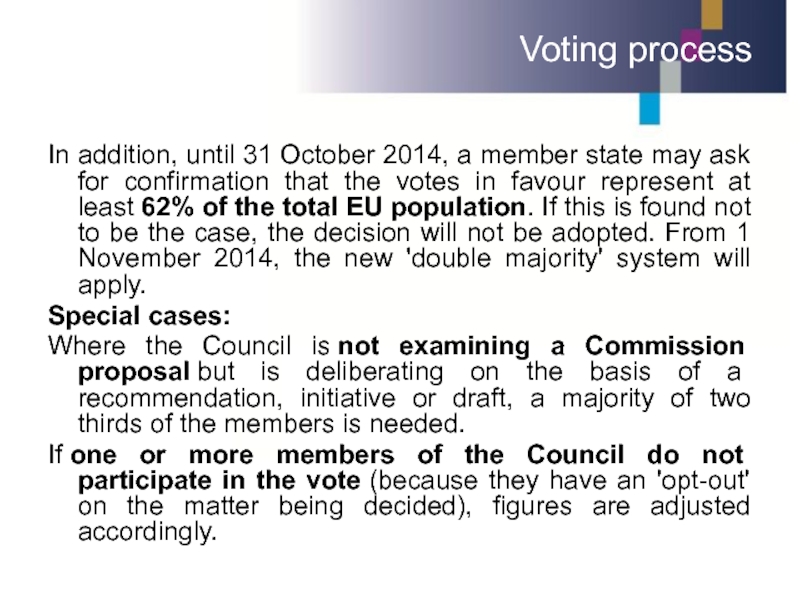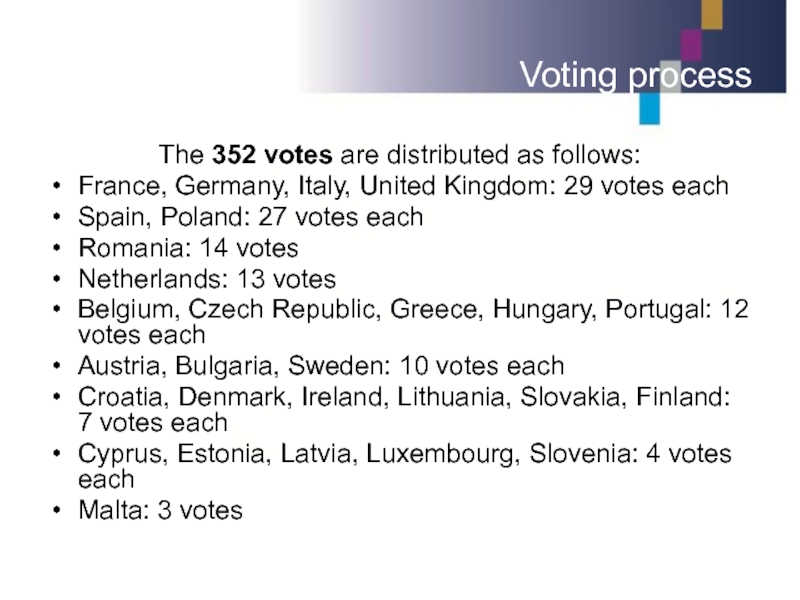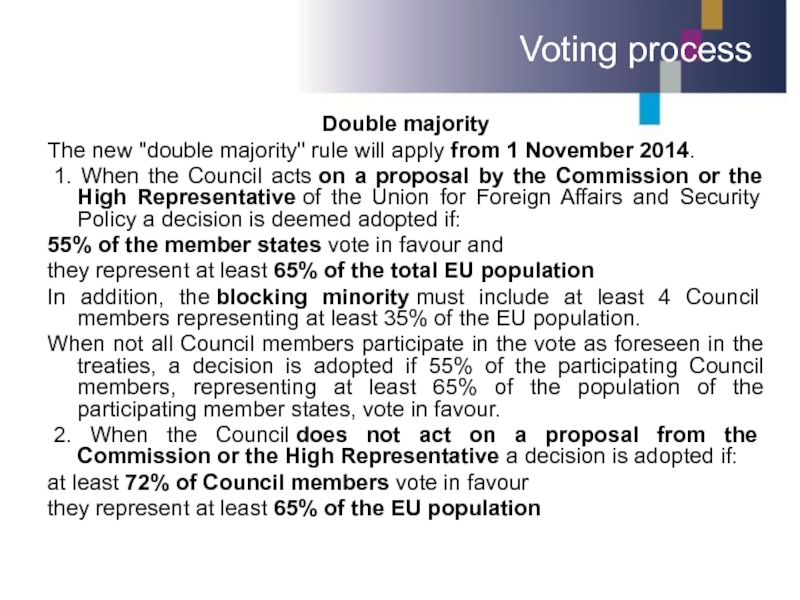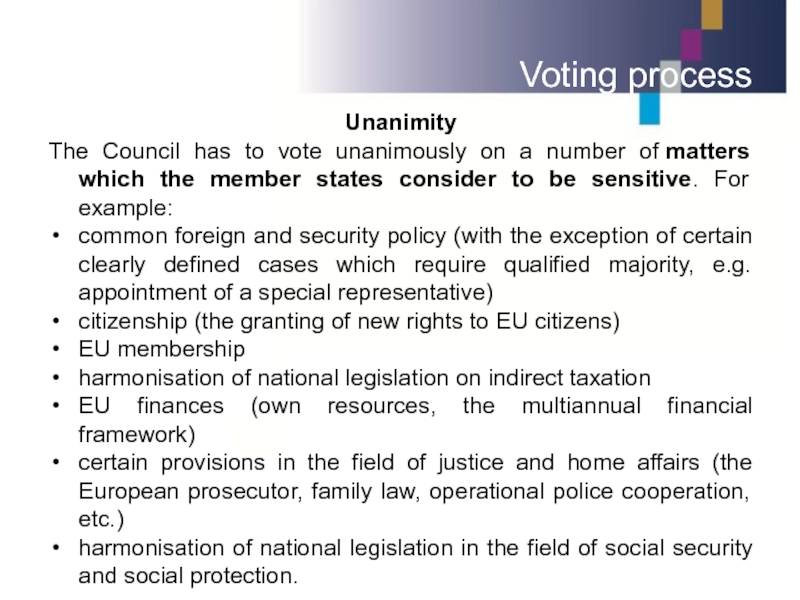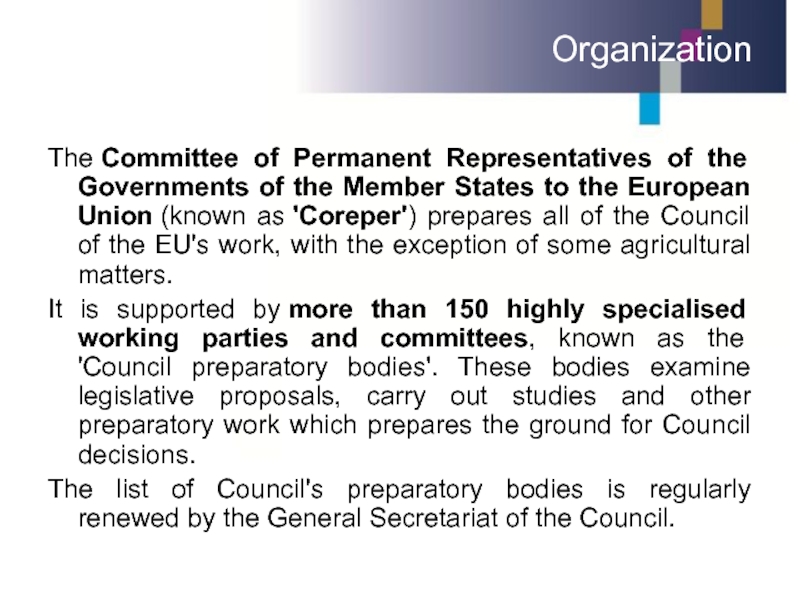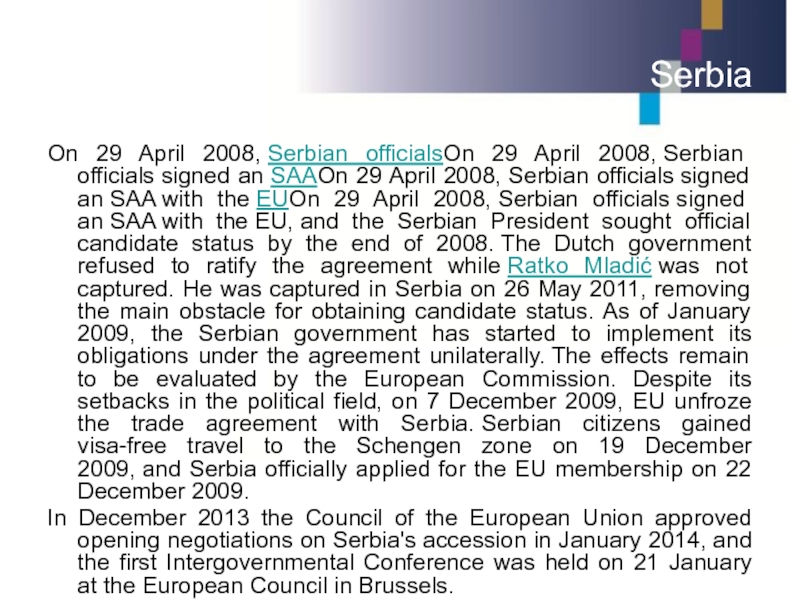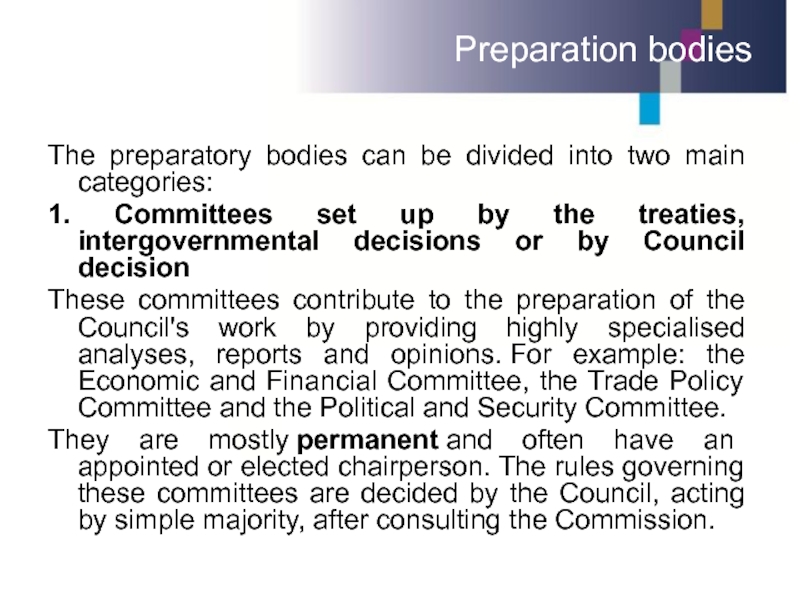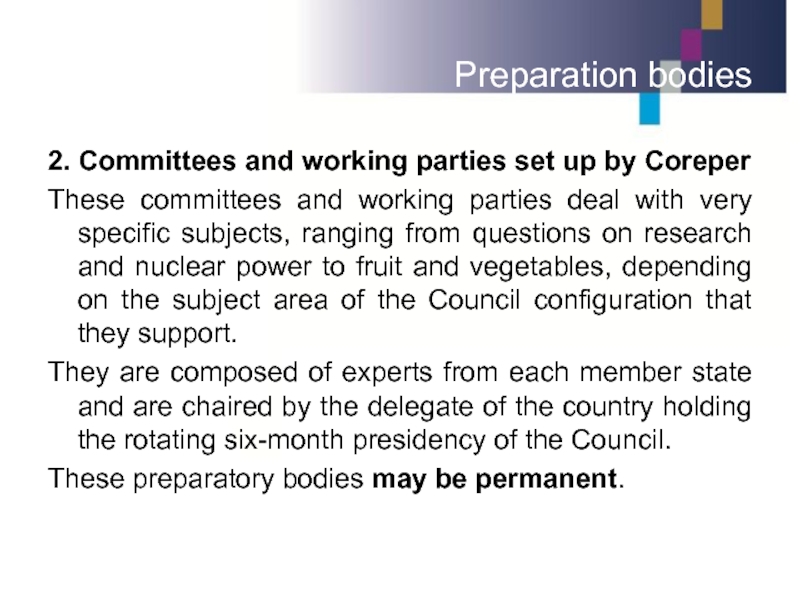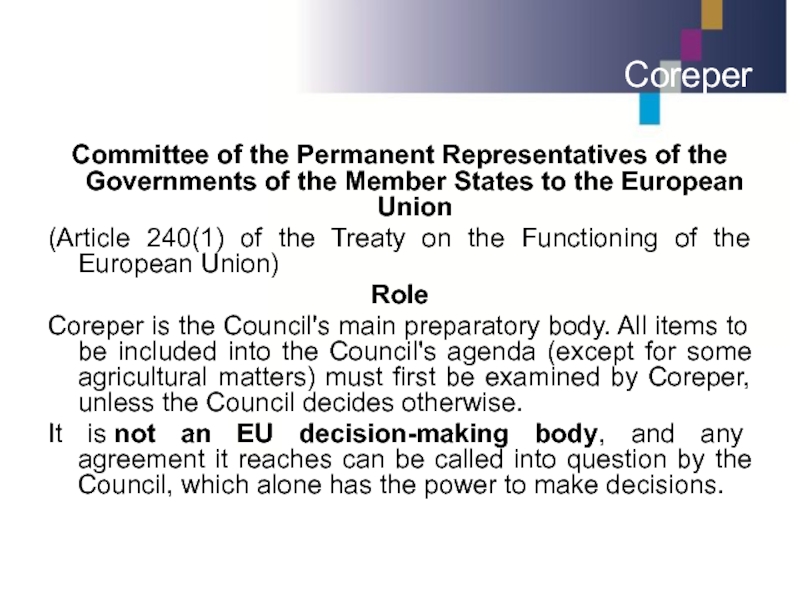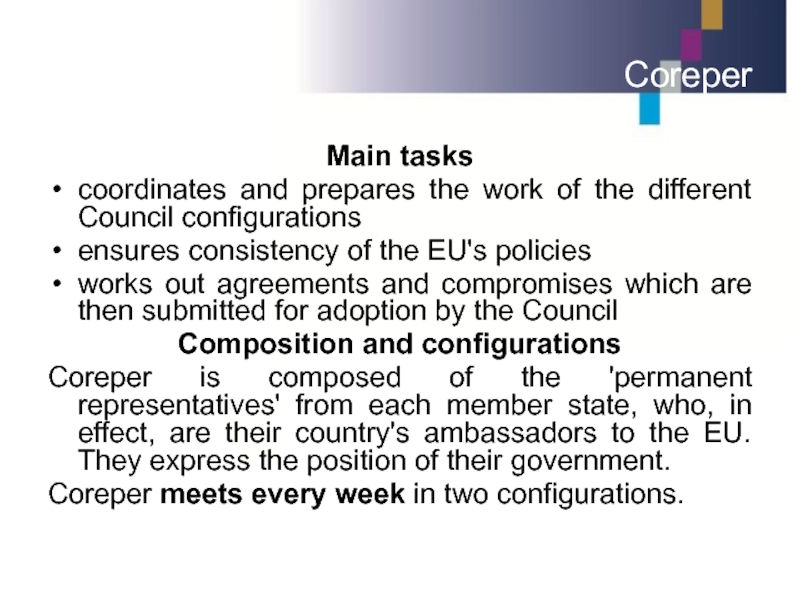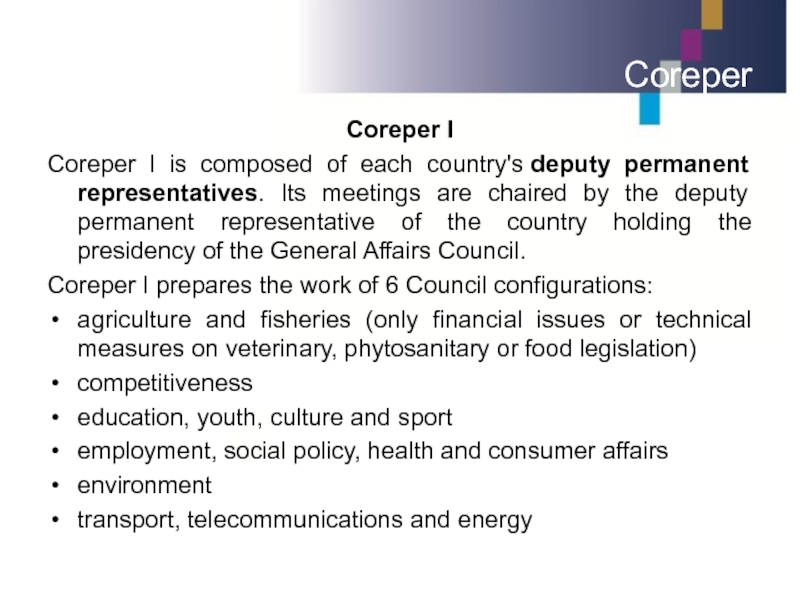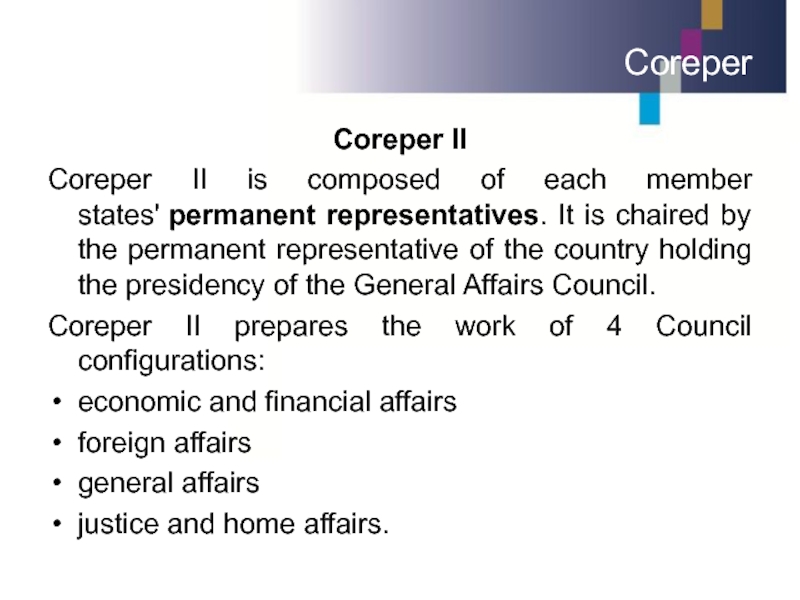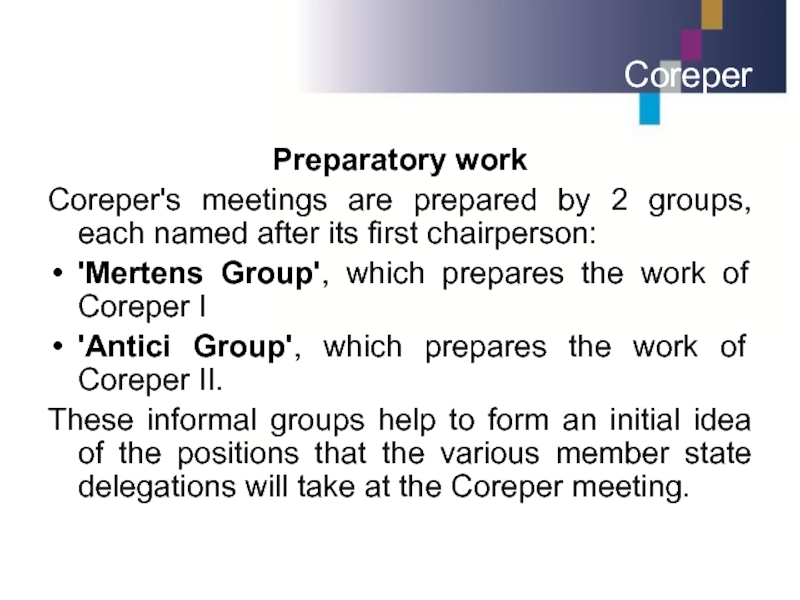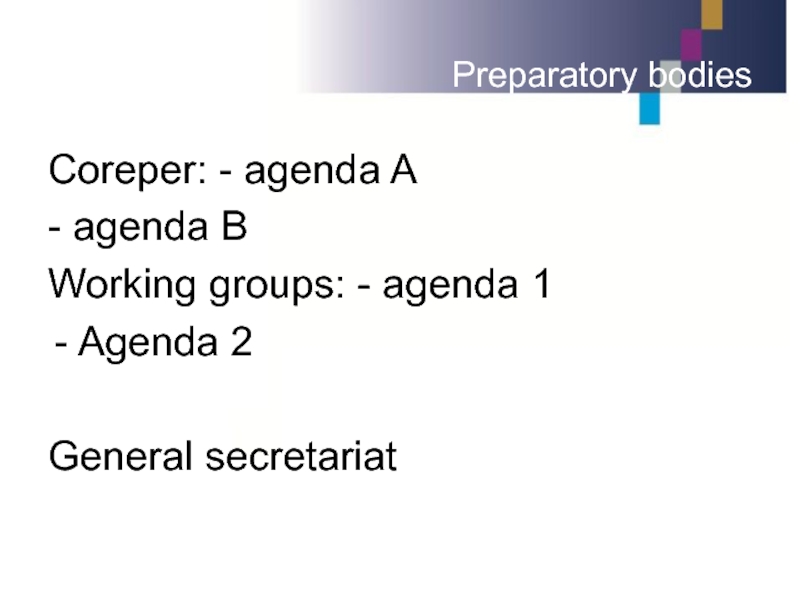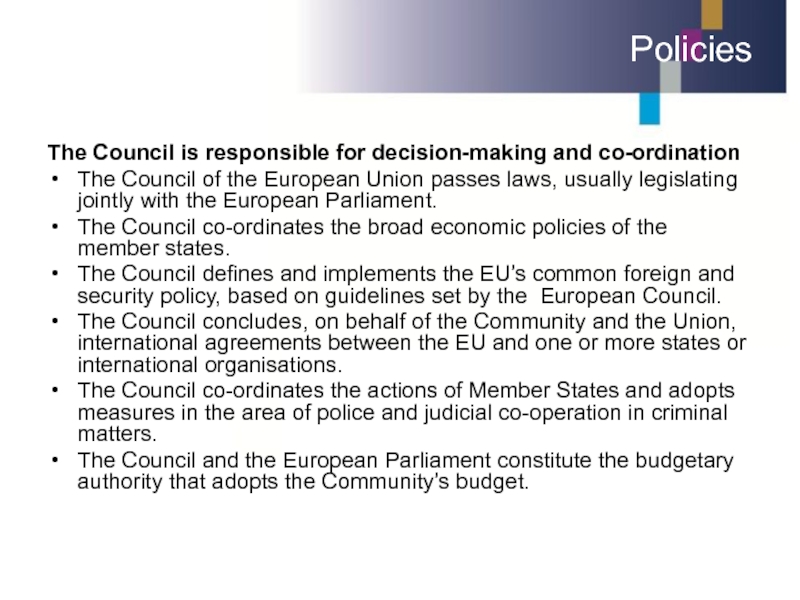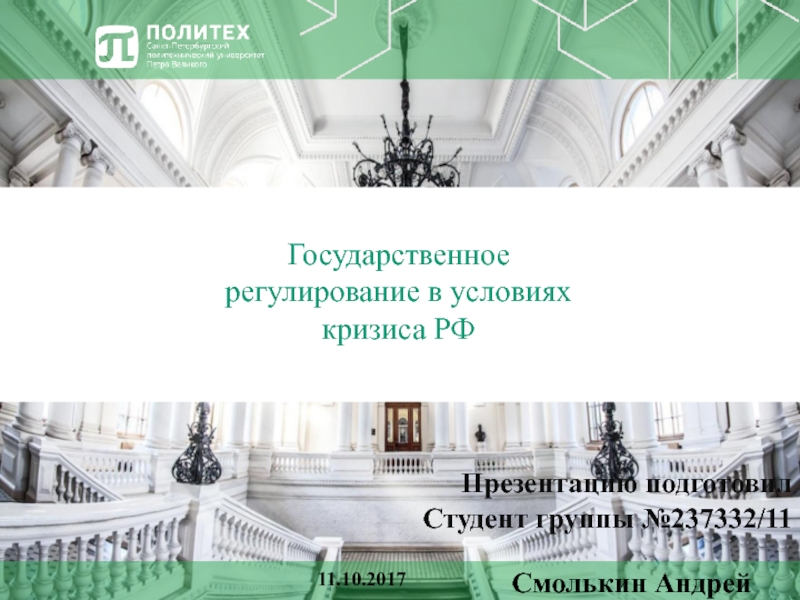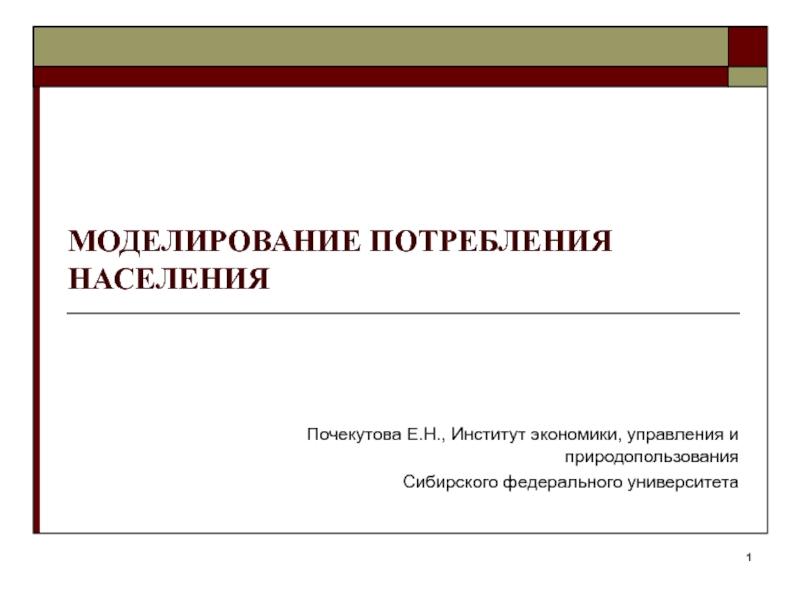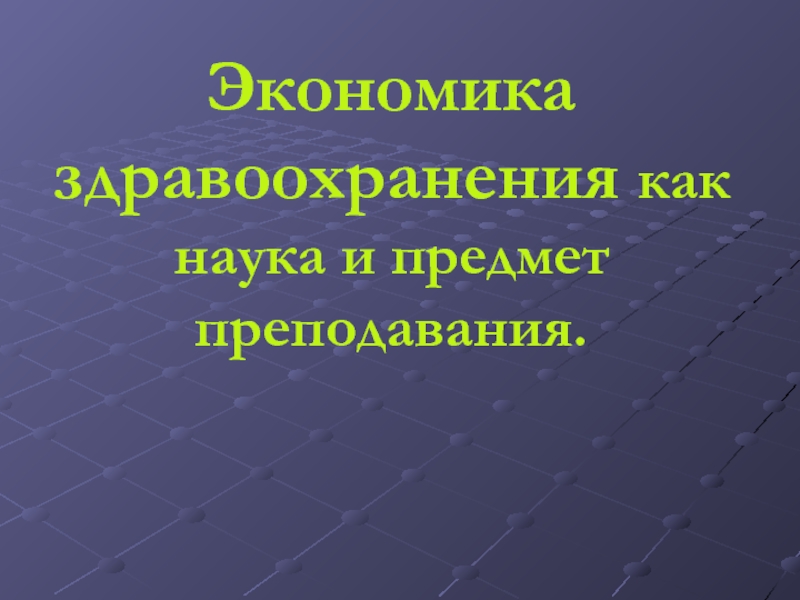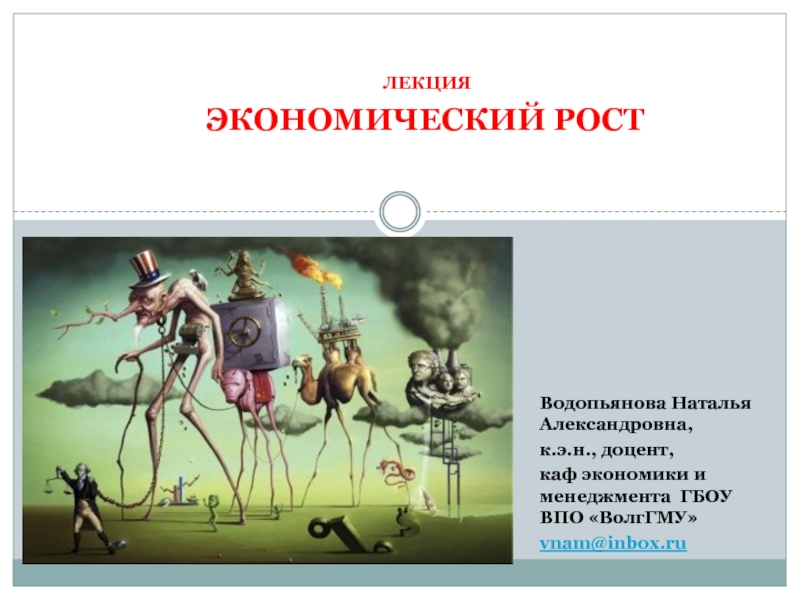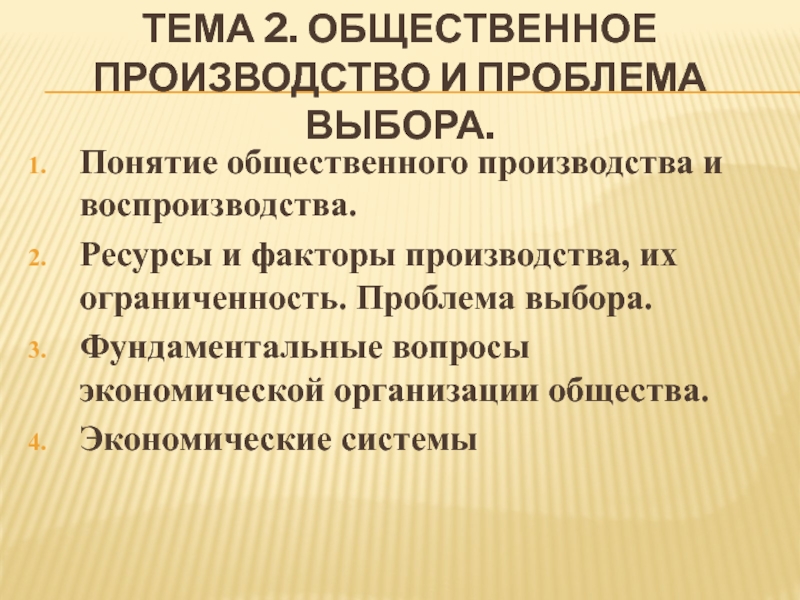- Главная
- Разное
- Дизайн
- Бизнес и предпринимательство
- Аналитика
- Образование
- Развлечения
- Красота и здоровье
- Финансы
- Государство
- Путешествия
- Спорт
- Недвижимость
- Армия
- Графика
- Культурология
- Еда и кулинария
- Лингвистика
- Английский язык
- Астрономия
- Алгебра
- Биология
- География
- Детские презентации
- Информатика
- История
- Литература
- Маркетинг
- Математика
- Медицина
- Менеджмент
- Музыка
- МХК
- Немецкий язык
- ОБЖ
- Обществознание
- Окружающий мир
- Педагогика
- Русский язык
- Технология
- Физика
- Философия
- Химия
- Шаблоны, картинки для презентаций
- Экология
- Экономика
- Юриспруденция
Council of the European Union презентация
Содержание
- 1. Council of the European Union
- 2. Questions History Organization Powers and functions Symbols
- 3. History The Council of the European Union (Council or Council
- 4. European Coal and Steel CommunityEuropean Coal and
- 5. History In 1957- the Council of the European
- 6. History Under the Merger TreatyUnder the Merger Treaty of 1967,
- 7. History The Treaty of LisbonThe Treaty of Lisbon abolished the
- 8. Organization The Presidency of the Council of the
- 9. Brussels - Justus Lipsius building Luxemburg – April, June, October
- 10. Organization 2013 Ireland
- 11. Organization One representative of every state
- 12. Organization Each three successive presidencies cooperate on
- 13. Configurations General Affairs Council (GAC) The General
- 14. Configurations The General Affairs Council is mainly
- 15. Foreign Affairs Council (FAC) The Foreign Affairs
- 16. Organization The Foreign Affairs Council is composed
- 17. Organization Economic and Financial Affairs Council (Ecofin)
- 18. Functions 2 groups: 1. internal organization, managing
- 19. 2. General political functions: ensuring the implementation
- 20. Depending on the issue under discussion, the
- 21. Voting process Voting is initiated by the President
- 22. Voting process Simple majority A simple majority
- 23. Voting process Qualified majority In qualified majority
- 24. Voting process In addition, until 31 October
- 25. Voting process The 352 votes are distributed as follows:
- 26. Voting process Double majority The new "double
- 27. Voting process Unanimity The Council has to
- 28. Organization The Committee of Permanent Representatives of the
- 29. Serbia On 29 April 2008, Serbian officialsOn 29
- 30. Preparation bodies The preparatory bodies can be
- 31. Preparation bodies 2. Committees and working parties
- 32. Coreper Committee of the Permanent Representatives of
- 33. Coreper Main tasks coordinates and prepares the
- 34. Coreper Coreper I Coreper I is composed
- 35. Coreper II Coreper II is composed of
- 36. Coreper Preparatory work Coreper's meetings are prepared
- 37. Preparatory bodies Coreper: - agenda A -
- 38. Policies The Council is responsible for decision-making
Слайд 3History
The Council of the European Union (Council or Council of Ministers). It is part
of the essentially bicameral). It is part of the essentially bicameral EU legislature). It is part of the essentially bicameral EU legislature, representing the executives). It is part of the essentially bicameral EU legislature, representing the executives of EU member states). It is part of the essentially bicameral EU legislature, representing the executives of EU member states, the other legislative body being the European Parliament.
Слайд 4European Coal and Steel CommunityEuropean Coal and Steel Community (ECSC) - "Special
Council of Ministers", set up to counterbalance the High Authority (the supranational executive, now the Commission). The original Council had limited powers: issues relating only to coal and steel were in the Authority's domain, and the Council's consent was only required on decisions outside coal and steel. As a whole, the Council only scrutinised the High Authority (the executive).
History
Слайд 5History
In 1957- the Council of the European Atomic Energy CommunityIn 1957- the
Council of the European Atomic Energy Community (EAEC) and the Council of the European Economic Community (EEC). Had more powers; the new executive bodies were known as "Commissions".
In 1965 the Council was hit by the "empty chair crisis". Due to disagreements between French PresidentIn 1965 the Council was hit by the "empty chair crisis". Due to disagreements between French President Charles de GaulleIn 1965 the Council was hit by the "empty chair crisis". Due to disagreements between French President Charles de Gaulle and the Commission's agriculture proposals, among other things, France boycotted all meetings of the Council. This halted the Council's work until the impasse was resolved the following year by the Luxembourg compromiseIn 1965 the Council was hit by the "empty chair crisis". Due to disagreements between French President Charles de Gaulle and the Commission's agriculture proposals, among other things, France boycotted all meetings of the Council. This halted the Council's work until the impasse was resolved the following year by the Luxembourg compromise. Although initiated by a gamble of the President of the Commission, Walter Hallstein, who afterwards lost the Presidency, the crisis exposed flaws in the Council's workings.
In 1965 the Council was hit by the "empty chair crisis". Due to disagreements between French PresidentIn 1965 the Council was hit by the "empty chair crisis". Due to disagreements between French President Charles de GaulleIn 1965 the Council was hit by the "empty chair crisis". Due to disagreements between French President Charles de Gaulle and the Commission's agriculture proposals, among other things, France boycotted all meetings of the Council. This halted the Council's work until the impasse was resolved the following year by the Luxembourg compromiseIn 1965 the Council was hit by the "empty chair crisis". Due to disagreements between French President Charles de Gaulle and the Commission's agriculture proposals, among other things, France boycotted all meetings of the Council. This halted the Council's work until the impasse was resolved the following year by the Luxembourg compromise. Although initiated by a gamble of the President of the Commission, Walter Hallstein, who afterwards lost the Presidency, the crisis exposed flaws in the Council's workings.
Слайд 6History
Under the Merger TreatyUnder the Merger Treaty of 1967, the ECSC's Special Council of
Ministers and the Council of the EAEC were merged into the Council of the EEC, which would act as a single Council of the European CommunitiesUnder the Merger Treaty of 1967, the ECSC's Special Council of Ministers and the Council of the EAEC were merged into the Council of the EEC, which would act as a single Council of the European Communities. In 1993, the Council adopted the name 'Council of the European Union', following the establishment of the European Union by the Maastricht TreatyUnder the Merger Treaty of 1967, the ECSC's Special Council of Ministers and the Council of the EAEC were merged into the Council of the EEC, which would act as a single Council of the European Communities. In 1993, the Council adopted the name 'Council of the European Union', following the establishment of the European Union by the Maastricht Treaty. That treaty strengthened the Council, with the addition of more intergovernmental elements in the three pillars system.
Слайд 7History
The Treaty of LisbonThe Treaty of Lisbon abolished the pillar system and gave further
powers to Parliament. It also merged the Council's High RepresentativeThe Treaty of Lisbon abolished the pillar system and gave further powers to Parliament. It also merged the Council's High Representative with theCommission's foreign policy headThe Treaty of Lisbon abolished the pillar system and gave further powers to Parliament. It also merged the Council's High Representative with theCommission's foreign policy head, with this new figure chairing the foreign affairs Council rather than the rotating presidency. The European Council was declared a separate institution from the Council, also chaired by a permanent president, and the different Council configurations were mentioned in the treaties for the first time.
Слайд 8Organization
The Presidency of the Council of the European Union is responsible for the
functioning of the Council of the European Union is responsible for the functioning of the Council of the European Union. It rotates among the member states of the EU every six months. The presidency is not an individual, but rather the position is held by a national government.
Слайд 10Organization
2013 Ireland Lithuania
2014 Greece
Italy
2015 Latvia Luxemburg
2016 Netherlands Slovakia
2017 Malta United Kingdom
2018 Estonia Bulgaria
2019 Austria Romania
2020 Finland
2015 Latvia Luxemburg
2016 Netherlands Slovakia
2017 Malta United Kingdom
2018 Estonia Bulgaria
2019 Austria Romania
2020 Finland
Слайд 11Organization
One representative of every state of minister level.
Article 16(9) of
the Treaty on European Union provides:
The Presidency of Council configurations, other than that of Foreign Affairs, shall be held by Member State representatives in the Council on the basis of equal rotation, in accordance with the conditions established in accordance with Article 236 of the Treaty on the Functioning of the European Union.
The Presidency of Council configurations, other than that of Foreign Affairs, shall be held by Member State representatives in the Council on the basis of equal rotation, in accordance with the conditions established in accordance with Article 236 of the Treaty on the Functioning of the European Union.
Слайд 12Organization
Each three successive presidencies cooperate on a "triple-shared presidency" work together
over an 18-month period to accomplish a common agenda by the current president simply continuing the work of the previous "lead-president" after the end of his/her term. This ensures more consistency in comparison to a usual single six-month presidency and each three includes a new member state. This allows new member states to hold the presidency sooner and helps old member states pass their experience to the new members.
The rotating presidency is probably not needed any more, with the 2009 reforms by the Treaty of Lisbon, but reforming it has proved incredibly difficult: it still enables little states to stand up and try to push forward vital policies; it represents a sharing of administrative burdens, enabling the coordination of policies, the stability of the Council agenda (through the troika) and providing learning and experience for member states' public administrations.
The rotating presidency is probably not needed any more, with the 2009 reforms by the Treaty of Lisbon, but reforming it has proved incredibly difficult: it still enables little states to stand up and try to push forward vital policies; it represents a sharing of administrative burdens, enabling the coordination of policies, the stability of the Council agenda (through the troika) and providing learning and experience for member states' public administrations.
Слайд 13Configurations
General Affairs Council (GAC)
The General Affairs Council coordinates preparations for European Council
meetings (the meeting of heads of state or government of the EU member states). Its task is to make sure that the work of the different Council configurations is consistent.
In addition, the General Affairs Council establishes the EU's Multiannual Financial Framework (the EU's 7 year budget which provides funding for all programmes and activities), supervises the EU enlargement process and accession negotiations, and deals with issues related to the EU's institutional setup.
The European Council can also entrust the General Affairs Council to deal with any other issue.
In addition, the General Affairs Council establishes the EU's Multiannual Financial Framework (the EU's 7 year budget which provides funding for all programmes and activities), supervises the EU enlargement process and accession negotiations, and deals with issues related to the EU's institutional setup.
The European Council can also entrust the General Affairs Council to deal with any other issue.
Слайд 14Configurations
The General Affairs Council is mainly made up of the European
Affairs ministers from all EU member states. The European Commission is usually represented by the Commissioner for inter-institutional relations, depending on the matter discussed.
GAC meetings are held once a month.
GAC meetings are held once a month.
Слайд 15Foreign Affairs Council (FAC)
The Foreign Affairs Council is responsible for the EU's
external action, covering a wide range of issues from foreign policy and defence to trade, development cooperation and humanitarian aid. It defines and implements the EU's foreign and security policy, which is based on the guidelines set by the European Council.
The FAC's main task, together with the European Commission and assisted by the High Representative of the Union for Foreign Affairs and Security Policy, is to ensure the unity, consistency and effectiveness of the EU's external action.
The High Representative and the member states may submit proposals to the FAC in the area of Common Foreign and Security Policy. The European Commission may also submit joint proposals with the High Representative in the area of Common Foreign and Security Policy.
The FAC's main task, together with the European Commission and assisted by the High Representative of the Union for Foreign Affairs and Security Policy, is to ensure the unity, consistency and effectiveness of the EU's external action.
The High Representative and the member states may submit proposals to the FAC in the area of Common Foreign and Security Policy. The European Commission may also submit joint proposals with the High Representative in the area of Common Foreign and Security Policy.
Configurations
Слайд 16Organization
The Foreign Affairs Council is composed of the foreign ministers from
all EU member states. Depending on the agenda, the Council also brings together:
defence ministers (Common Security and Defence Policy)
development ministers (development cooperation)
trade ministers (common commercial policy)
Meetings of the Foreign Affairs Council are chaired by the High Representative of the Union for Foreign Affairs and Security Policy, currently Catherine Ashton.
However, when the Foreign Affairs Council discusses common commercial policy issues, it is presided by the representative of the EU member state holding the six-monthly rotating presidency of the Council of the EU.
The High Representative is assisted by the European External Action Service (EEAS).
The Foreign Affairs council meets once a month.
defence ministers (Common Security and Defence Policy)
development ministers (development cooperation)
trade ministers (common commercial policy)
Meetings of the Foreign Affairs Council are chaired by the High Representative of the Union for Foreign Affairs and Security Policy, currently Catherine Ashton.
However, when the Foreign Affairs Council discusses common commercial policy issues, it is presided by the representative of the EU member state holding the six-monthly rotating presidency of the Council of the EU.
The High Representative is assisted by the European External Action Service (EEAS).
The Foreign Affairs council meets once a month.
Слайд 17Organization
Economic and Financial Affairs Council (Ecofin)
Justice and Home Affairs Council (JHA)
The
Employment, Social Policy, Health and Consumer Affairs Council (EPSCO)
Competitiveness Council (COMPET)
Transport, Telecommunications and Energy Council (TTE)
Agriculture and Fisheries Council (AGRIFISH)
Education, Youth, Culture and Sport Council (EYCS)
Competitiveness Council (COMPET)
Transport, Telecommunications and Energy Council (TTE)
Agriculture and Fisheries Council (AGRIFISH)
Education, Youth, Culture and Sport Council (EYCS)
Слайд 18Functions
2 groups: 1. internal organization, managing of Council work and its
bodies:
convening meetings of the Council
the formation of the agenda in all its “configurations“
no later than one week before presidency of the Council announces the semester program
a list of bills and other decisions, the adoption of which is scheduled for the next six months;
preside over the meetings of the Council and its subsidiary bodies,
put questions to the vote
sign the decisions
+ tour de table
convening meetings of the Council
the formation of the agenda in all its “configurations“
no later than one week before presidency of the Council announces the semester program
a list of bills and other decisions, the adoption of which is scheduled for the next six months;
preside over the meetings of the Council and its subsidiary bodies,
put questions to the vote
sign the decisions
+ tour de table
Слайд 192. General political functions: ensuring the implementation of the decisions taken,
the results of most of the decisions initiatives Chairman
official representation of the EU in the international arena
Responsibility – political character, no information in treaties
official representation of the EU in the international arena
Responsibility – political character, no information in treaties
Functions
Слайд 20Depending on the issue under discussion, the Council of the EU
takes its decisions by:
simple majority (15 member states vote in favour)
qualified majority (260 votes from at least 15 member states are in favour), or
unanimous vote (all votes are in favour)
The Council can vote only if a majority of its members is present. A member of the Council may only act on the behalf of one other member.
The Council can vote on a legislative act 8 weeks after the draft act has been sent to national parliaments for their examination. The national parliaments have to decide whether the draft legislation complies with the principle of subsidiarity. Earlier voting is only possible in special urgent cases.
simple majority (15 member states vote in favour)
qualified majority (260 votes from at least 15 member states are in favour), or
unanimous vote (all votes are in favour)
The Council can vote only if a majority of its members is present. A member of the Council may only act on the behalf of one other member.
The Council can vote on a legislative act 8 weeks after the draft act has been sent to national parliaments for their examination. The national parliaments have to decide whether the draft legislation complies with the principle of subsidiarity. Earlier voting is only possible in special urgent cases.
Voting process
Слайд 21Voting process
Voting is initiated by the President of the Council. A member
of the Council or the Commission can also initiate the voting procedure, but a majority of the Council's members have to approve this initiative.
The results of Council votes are automatically made public when the Council acts in its capacity as legislator.
If a member wants to add an explanatory note to the vote, this note will also be made public, if a legal act is adopted. In other cases, when explanations of votes are not automatically published, it can be made public on the request of the author.
The results of Council votes are automatically made public when the Council acts in its capacity as legislator.
If a member wants to add an explanatory note to the vote, this note will also be made public, if a legal act is adopted. In other cases, when explanations of votes are not automatically published, it can be made public on the request of the author.
Слайд 22Voting process
Simple majority
A simple majority is reached if at least 15 Council
members vote in favour.
The Council takes decisions by simple majority:
in procedural matters, such as the adoption of its own rules of procedure and organisation of its Secretariat General, the adoption of the rules governing the committees foreseen in the treaties, etc.
to request the Commission to undertake studies or submit proposals
The Council takes decisions by simple majority:
in procedural matters, such as the adoption of its own rules of procedure and organisation of its Secretariat General, the adoption of the rules governing the committees foreseen in the treaties, etc.
to request the Commission to undertake studies or submit proposals
Слайд 23Voting process
Qualified majority
In qualified majority voting, each member state representative has
a certain number of votes. The weighting of votes is set out in the treaties and roughly reflects the size of population of each member state.
The qualified majority is reached if the following two conditions are met:
a majority of member states - 15 member states - vote in favour
a minimum of 260 votes out of the total 352 votes are cast in favour
The qualified majority is reached if the following two conditions are met:
a majority of member states - 15 member states - vote in favour
a minimum of 260 votes out of the total 352 votes are cast in favour
Слайд 24Voting process
In addition, until 31 October 2014, a member state may
ask for confirmation that the votes in favour represent at least 62% of the total EU population. If this is found not to be the case, the decision will not be adopted. From 1 November 2014, the new 'double majority' system will apply.
Special cases:
Where the Council is not examining a Commission proposal but is deliberating on the basis of a recommendation, initiative or draft, a majority of two thirds of the members is needed.
If one or more members of the Council do not participate in the vote (because they have an 'opt-out' on the matter being decided), figures are adjusted accordingly.
Special cases:
Where the Council is not examining a Commission proposal but is deliberating on the basis of a recommendation, initiative or draft, a majority of two thirds of the members is needed.
If one or more members of the Council do not participate in the vote (because they have an 'opt-out' on the matter being decided), figures are adjusted accordingly.
Слайд 25Voting process
The 352 votes are distributed as follows:
France, Germany, Italy, United Kingdom: 29 votes
each
Spain, Poland: 27 votes each
Romania: 14 votes
Netherlands: 13 votes
Belgium, Czech Republic, Greece, Hungary, Portugal: 12 votes each
Austria, Bulgaria, Sweden: 10 votes each
Croatia, Denmark, Ireland, Lithuania, Slovakia, Finland: 7 votes each
Cyprus, Estonia, Latvia, Luxembourg, Slovenia: 4 votes each
Malta: 3 votes
Spain, Poland: 27 votes each
Romania: 14 votes
Netherlands: 13 votes
Belgium, Czech Republic, Greece, Hungary, Portugal: 12 votes each
Austria, Bulgaria, Sweden: 10 votes each
Croatia, Denmark, Ireland, Lithuania, Slovakia, Finland: 7 votes each
Cyprus, Estonia, Latvia, Luxembourg, Slovenia: 4 votes each
Malta: 3 votes
Слайд 26Voting process
Double majority
The new "double majority" rule will apply from 1 November
2014.
1. When the Council acts on a proposal by the Commission or the High Representative of the Union for Foreign Affairs and Security Policy a decision is deemed adopted if:
55% of the member states vote in favour and
they represent at least 65% of the total EU population
In addition, the blocking minority must include at least 4 Council members representing at least 35% of the EU population.
When not all Council members participate in the vote as foreseen in the treaties, a decision is adopted if 55% of the participating Council members, representing at least 65% of the population of the participating member states, vote in favour.
2. When the Council does not act on a proposal from the Commission or the High Representative a decision is adopted if:
at least 72% of Council members vote in favour
they represent at least 65% of the EU population
1. When the Council acts on a proposal by the Commission or the High Representative of the Union for Foreign Affairs and Security Policy a decision is deemed adopted if:
55% of the member states vote in favour and
they represent at least 65% of the total EU population
In addition, the blocking minority must include at least 4 Council members representing at least 35% of the EU population.
When not all Council members participate in the vote as foreseen in the treaties, a decision is adopted if 55% of the participating Council members, representing at least 65% of the population of the participating member states, vote in favour.
2. When the Council does not act on a proposal from the Commission or the High Representative a decision is adopted if:
at least 72% of Council members vote in favour
they represent at least 65% of the EU population
Слайд 27Voting process
Unanimity
The Council has to vote unanimously on a number of matters
which the member states consider to be sensitive. For example:
common foreign and security policy (with the exception of certain clearly defined cases which require qualified majority, e.g. appointment of a special representative)
citizenship (the granting of new rights to EU citizens)
EU membership
harmonisation of national legislation on indirect taxation
EU finances (own resources, the multiannual financial framework)
certain provisions in the field of justice and home affairs (the European prosecutor, family law, operational police cooperation, etc.)
harmonisation of national legislation in the field of social security and social protection.
common foreign and security policy (with the exception of certain clearly defined cases which require qualified majority, e.g. appointment of a special representative)
citizenship (the granting of new rights to EU citizens)
EU membership
harmonisation of national legislation on indirect taxation
EU finances (own resources, the multiannual financial framework)
certain provisions in the field of justice and home affairs (the European prosecutor, family law, operational police cooperation, etc.)
harmonisation of national legislation in the field of social security and social protection.
Слайд 28Organization
The Committee of Permanent Representatives of the Governments of the Member States
to the European Union (known as 'Coreper') prepares all of the Council of the EU's work, with the exception of some agricultural matters.
It is supported by more than 150 highly specialised working parties and committees, known as the 'Council preparatory bodies'. These bodies examine legislative proposals, carry out studies and other preparatory work which prepares the ground for Council decisions.
The list of Council's preparatory bodies is regularly renewed by the General Secretariat of the Council.
It is supported by more than 150 highly specialised working parties and committees, known as the 'Council preparatory bodies'. These bodies examine legislative proposals, carry out studies and other preparatory work which prepares the ground for Council decisions.
The list of Council's preparatory bodies is regularly renewed by the General Secretariat of the Council.
Слайд 29Serbia
On 29 April 2008, Serbian officialsOn 29 April 2008, Serbian officials signed an SAAOn 29
April 2008, Serbian officials signed an SAA with the EUOn 29 April 2008, Serbian officials signed an SAA with the EU, and the Serbian President sought official candidate status by the end of 2008. The Dutch government refused to ratify the agreement while Ratko Mladić was not captured. He was captured in Serbia on 26 May 2011, removing the main obstacle for obtaining candidate status. As of January 2009, the Serbian government has started to implement its obligations under the agreement unilaterally. The effects remain to be evaluated by the European Commission. Despite its setbacks in the political field, on 7 December 2009, EU unfroze the trade agreement with Serbia. Serbian citizens gained visa-free travel to the Schengen zone on 19 December 2009, and Serbia officially applied for the EU membership on 22 December 2009.
In December 2013 the Council of the European Union approved opening negotiations on Serbia's accession in January 2014, and the first Intergovernmental Conference was held on 21 January at the European Council in Brussels.
In December 2013 the Council of the European Union approved opening negotiations on Serbia's accession in January 2014, and the first Intergovernmental Conference was held on 21 January at the European Council in Brussels.
Слайд 30Preparation bodies
The preparatory bodies can be divided into two main categories:
1.
Committees set up by the treaties, intergovernmental decisions or by Council decision
These committees contribute to the preparation of the Council's work by providing highly specialised analyses, reports and opinions. For example: the Economic and Financial Committee, the Trade Policy Committee and the Political and Security Committee.
They are mostly permanent and often have an appointed or elected chairperson. The rules governing these committees are decided by the Council, acting by simple majority, after consulting the Commission.
These committees contribute to the preparation of the Council's work by providing highly specialised analyses, reports and opinions. For example: the Economic and Financial Committee, the Trade Policy Committee and the Political and Security Committee.
They are mostly permanent and often have an appointed or elected chairperson. The rules governing these committees are decided by the Council, acting by simple majority, after consulting the Commission.
Слайд 31Preparation bodies
2. Committees and working parties set up by Coreper
These committees
and working parties deal with very specific subjects, ranging from questions on research and nuclear power to fruit and vegetables, depending on the subject area of the Council configuration that they support.
They are composed of experts from each member state and are chaired by the delegate of the country holding the rotating six-month presidency of the Council.
These preparatory bodies may be permanent.
They are composed of experts from each member state and are chaired by the delegate of the country holding the rotating six-month presidency of the Council.
These preparatory bodies may be permanent.
Слайд 32Coreper
Committee of the Permanent Representatives of the Governments of the Member
States to the European Union
(Article 240(1) of the Treaty on the Functioning of the European Union)
Role
Coreper is the Council's main preparatory body. All items to be included into the Council's agenda (except for some agricultural matters) must first be examined by Coreper, unless the Council decides otherwise.
It is not an EU decision-making body, and any agreement it reaches can be called into question by the Council, which alone has the power to make decisions.
(Article 240(1) of the Treaty on the Functioning of the European Union)
Role
Coreper is the Council's main preparatory body. All items to be included into the Council's agenda (except for some agricultural matters) must first be examined by Coreper, unless the Council decides otherwise.
It is not an EU decision-making body, and any agreement it reaches can be called into question by the Council, which alone has the power to make decisions.
Слайд 33Coreper
Main tasks
coordinates and prepares the work of the different Council configurations
ensures
consistency of the EU's policies
works out agreements and compromises which are then submitted for adoption by the Council
Composition and configurations
Coreper is composed of the 'permanent representatives' from each member state, who, in effect, are their country's ambassadors to the EU. They express the position of their government.
Coreper meets every week in two configurations.
works out agreements and compromises which are then submitted for adoption by the Council
Composition and configurations
Coreper is composed of the 'permanent representatives' from each member state, who, in effect, are their country's ambassadors to the EU. They express the position of their government.
Coreper meets every week in two configurations.
Слайд 34Coreper
Coreper I
Coreper I is composed of each country's deputy permanent representatives. Its
meetings are chaired by the deputy permanent representative of the country holding the presidency of the General Affairs Council.
Coreper I prepares the work of 6 Council configurations:
agriculture and fisheries (only financial issues or technical measures on veterinary, phytosanitary or food legislation)
competitiveness
education, youth, culture and sport
employment, social policy, health and consumer affairs
environment
transport, telecommunications and energy
Coreper I prepares the work of 6 Council configurations:
agriculture and fisheries (only financial issues or technical measures on veterinary, phytosanitary or food legislation)
competitiveness
education, youth, culture and sport
employment, social policy, health and consumer affairs
environment
transport, telecommunications and energy
Слайд 35Coreper II
Coreper II is composed of each member states' permanent representatives. It
is chaired by the permanent representative of the country holding the presidency of the General Affairs Council.
Coreper II prepares the work of 4 Council configurations:
economic and financial affairs
foreign affairs
general affairs
justice and home affairs.
Coreper II prepares the work of 4 Council configurations:
economic and financial affairs
foreign affairs
general affairs
justice and home affairs.
Coreper
Слайд 36Coreper
Preparatory work
Coreper's meetings are prepared by 2 groups, each named after
its first chairperson:
'Mertens Group', which prepares the work of Coreper I
'Antici Group', which prepares the work of Coreper II.
These informal groups help to form an initial idea of the positions that the various member state delegations will take at the Coreper meeting.
'Mertens Group', which prepares the work of Coreper I
'Antici Group', which prepares the work of Coreper II.
These informal groups help to form an initial idea of the positions that the various member state delegations will take at the Coreper meeting.
Слайд 37Preparatory bodies
Coreper: - agenda A
- agenda B
Working groups: - agenda 1
Agenda
2
General secretariat
General secretariat
Слайд 38Policies
The Council is responsible for decision-making and co-ordination
The Council of the
European Union passes laws, usually legislating jointly with the European Parliament.
The Council co-ordinates the broad economic policies of the member states.
The Council defines and implements the EU’s common foreign and security policy, based on guidelines set by the European Council.
The Council concludes, on behalf of the Community and the Union, international agreements between the EU and one or more states or international organisations.
The Council co-ordinates the actions of Member States and adopts measures in the area of police and judicial co-operation in criminal matters.
The Council and the European Parliament constitute the budgetary authority that adopts the Community’s budget.
The Council co-ordinates the broad economic policies of the member states.
The Council defines and implements the EU’s common foreign and security policy, based on guidelines set by the European Council.
The Council concludes, on behalf of the Community and the Union, international agreements between the EU and one or more states or international organisations.
The Council co-ordinates the actions of Member States and adopts measures in the area of police and judicial co-operation in criminal matters.
The Council and the European Parliament constitute the budgetary authority that adopts the Community’s budget.
